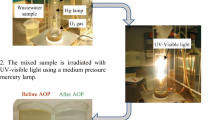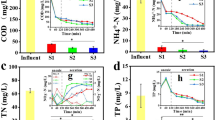Abstract
This study investigated the changes of toxic compounds in coking wastewater with biological treatment (anaerobic reactor, anoxic reactor and aerobic-membrane bioreactor, A1/A2/O-MBR) and advanced physicochemical treatment (Fenton oxidation and activated carbon adsorption) stages. As the biological treatment stages preceding, the inhibition effect of coking wastewater on the luminescence of Vibrio qinghaiensis sp. Nov. Q67 decreased. Toxic units (TU) of coking wastewater were removed by A1/A2/O-MBR treatment process, however approximately 30 % TU remained in the biologically treated effluent. There is a tendency that fewer and fewer residual organic compounds could exert equal acute toxicity during the biological treatment stages. Activated carbon adsorption further removed toxic pollutants of biologically treated effluent but the Fenton effluent increased acute toxicity. The composition of coking wastewater during the treatment was evaluated using the three-dimensional fluorescence spectra, gas chromatography–mass spectrometry (GC-MS). The organic compounds with high polarity were the main cause of acute toxicity in the coking wastewater. Aromatic protein-like matters in the coking wastewater with low biodegradability and high toxicity contributed mostly to the remaining acute toxicity of the biologically treated effluents. Chlorine generated from the oxidation process was responsible for the acute toxicity increase after Fenton oxidation. Therefore, the incorporation of appropriate advanced physicochemical treatment process, e.g., activated carbon adsorption, should be implemented following biological treatment processes to meet the stricter discharge standards and be safer to the environment.





Similar content being viewed by others
References
Altenburger R, Backhaus T, Boedeker W, Faust M, Scholze M, Grimme LH (2000) Predictability of the toxicity of multiple chemical mixtures to Vibrio fischeri: mixtures composed of similarly acting chemicals. Environmental Toxicology and Chemistry 19:2341–2347
Barata C, Calbet A, Saiz E, Ortiz L, Bayona JM (2005) Predicting single and mixture toxicity of petrogenic polycyclic aromatic hydrocarbons to the copepod Oithona davisae. Environmental Toxicology and Chemistry 24:2992–2999
Black JA, Birge WJ, Westerman AG, Francis PC (1983) Comparative aquatic toxicology of aromatic-hydrocarbons. Fundamental and Applied Toxicology 3:353–358
Cao N, Yang M, Zhang Y, Hu J, Ike M, Hirotsuji J, Matsui H, Inoue D, Sei K (2009) Evaluation of wastewater reclamation technologies based on in vitro and in vivo bioassays. Science of the Total Environment 407:1588–1597
Chen CM, Shih ML, Lee SZ, Wang JS (2001) Increased toxicity of textile effluents by a chlorination process using sodium hypochlorite. Water Science and Technology 43:1–8
Chen W, Westerhoff P, Leenheer JA, Booksh K (2003) Fluorescence excitation—emission matrix regional integration to quantify spectra for dissolved organic matter. Environmental Science & Technology 37:5701–5710
De Vlaming V, Connor V, DiGiorgio C, Bailey HC, Deanovic LA, Hinton DE (2000) Application of whole effluent toxicity test procedures to ambient water quality assessment. Environmental Toxicology and Chemistry 19:42–62
Farre M, Barcelo D (2003) Toxicity testing of wastewater and sewage sludge by biosensors, bioassays and chemical analysis. Trac-Trends in Analytical Chemistry 22:299–310
Girotti S, Ferri EN, Fumo MG, Maiolini E (2008) Monitoring of environmental pollutants by bioluminescent bacteria. Analytica Chimica Acta 608:2–29
Han M, Li G, Sang N, Dong Y (2011) Investigating the bio-toxicity of coking wastewater using Zea mays L. assay. Ecotoxicology and Environmental Safety 74:1050–1056
Hudson N, Baker A, Reynolds D (2007) Fluorescence analysis of dissolved organic matter in natural, waste and polluted waters—a review. River Research and Applications 23:631–649
Jiang M, Li Y, Gu G (2005) Study on toxicity of nitrogenous heterocyclic compounds to aquatic organisms. Acta Scientiae Circumstantiae 25:1253–1258
Kahru A, Pollumaa L, Reiman R, Ratsep A, Liiders M, Maloveryan A (2000) The toxicity and biodegradability of eight main phenolic compounds characteristic to the oil-shale industry wastewaters: a test battery approach. Environmental Toxicology 15:431–442
Kong Y, Zhu L, Lv M, Xu X, Qi H (2012) Research advances in water environment remediation and wastewater treatment based on three dimensional fluorescence spectroscopy technology. Ecology and Environmental Sciences 21:1647–1654
Ma M, Tong Z, Wang Z, Zhu W (1999) Acute toxicity bioassay using the freshwater luminescent bacterium Vibrio-qinghaiensis sp. Nov.-Q67. Bulletin of Environmental Contamination and Toxicology 62:247–253
Parvez S, Venkataraman C, Mukherji S (2006) A review on advantages of implementing luminescence inhibition test (Vibrio fischeri) for acute toxicity prediction of chemicals. Environ Int 32:265–268
Persoone G, Marsalek B, Blinova I, Torokne A, Zarina D, Manusadzianas L, Nalecz-Jawecki G, Tofan L, Stepanova N, Tothova L, Kolar B (2003) A practical and user-friendly toxicity classification system with microbiotests for natural waters and wastewaters. Environmental Toxicology 18:395–402
Shen G, Yan G, Yu X, Liu Y, Song L, Xu L (1999) The toxic effects of naphthalene and its derivants on Chlorella vulgaris. Acta Hydrobiologica Sinica 23:460–468
Ton S-S, Chang S-H, Hsu L-Y, Wang M-H, Wang K-S (2012) Evaluation of acute toxicity and teratogenic effects of disinfectants by Daphnia magna embryo assay. Environmental Pollution 168:54–61
USEPA (1991) Technical support document for water quality-based toxics control. Office of Research and Development, Washington
Van der Meer JR (2006) Environmental pollution promotes selection of microbial degradation pathways. Front Ecol Environ 4:35–42
Wang C, Zhang M, Liu W, Ye M, Su F (2015) Effluent characteristics of advanced treatment for biotreated coking wastewater by electrochemical technology using BDD anodes. Environmental Science And Pollution Research 22:6827–6834
Wei C, He M, Ren Y, Li G, Chen J (2007) Pollution characteristics of coking wastewater and control strategies: biological treatment process and technology. Acta Scientiae Circumstantiae 27:1083–1093 (in Chinese)
Wei X, Zhang Z, Fan Q, Yuan X, Guo D (2012) The effect of treatment stages on the cokingwastewater hazardous compounds and their toxicity. J Hazard Mater 239:135–141
Wu Y, Zhou S, Qin F, Ye X, Zheng K (2010) Modeling physical and oxidative removal properties of Fenton process for treatment of landfill leachate using response surface methodology (RSM). Journal of Hazardous Materials 180:456–465
Ye ZF, Zhao QL, Zhang MH, Gao YC (2011) Acute toxicity evaluation of explosive wastewater by bacterial bioluminescence assays using a freshwater luminescent bacterium, Vibrio qinghaiensis sp Nov. Journal of Hazardous Materials 186:1351–1354
Yu X-Y (2004) Critical evaluation of rate constants and equilibrium constants of hydrogen peroxide photolysis in acidic aqueous solutions containing chloride ions. Journal of Physical and Chemical Reference Data 33:17
Zhang M, Tay JH, Qian Y, Gu XS (1998) Coke plant wastewater treatment by fixed biofilm system for COD and NH3-N removal. Water Research 32:519–527
Zhang W, Wei C, Yan B, Feng C, Zhao G, Lin C, Yuan M, Wu C, Ren Y, Hu Y (2013) Identification and removal of polycyclic aromatic hydrocarbons in wastewater treatment processes from coke production plants. Environmental Science And Pollution Research 20:6418–6432
Zhao W, Huang X, Lee D (2009) Enhanced treatment of coke plant wastewater using an anaerobic-anoxic-oxic membrane bioreactor system. Sep Purif Technol 66:279–286
Zhao J-L, Jiang Y-X, Yan B, Wei C, Zhang L-J, Ying G-G (2014) Multispecies acute toxicity evaluation of wastewaters from different treatment stages in a coking wastewater-treatment plant. Environmental Toxicology and Chemistry 33:1967–1975
Zhu W, Wang J, Chen X, Zhaxi C, Yang Y, Song Y (1994) A new species of luminous bacteria Vibrio qinghaiensis sp. nov. Oceanologia Et Limnologia Sinica 3, 006
Zhu X, Chen L, Liu R, Liu C, Pan Z (2013) Biotoxicity evaluation of coking wastewater treated with different technologies using Japanese medaka (Oryzias latipes). Environmental Science-Processes & Impacts 15:1391–1396
Acknowledgments
This work was supported by the National High-Tech Research and Development Program of China (863 Program, 2013AA062705-1), the National Natural Science Funds (No.51308319) and Open Funds from Jiangsu Key Laboratory of Chemical Pollution Control and Resources Reuse (30916014102). The authors appreciated Professor Zijian Wang from the Research Center for Eco-Environmental Sciences, Beijing, China, for the luminescence inhibition test.
Author information
Authors and Affiliations
Corresponding author
Additional information
Responsible editor: Gerald Thouand
Rights and permissions
About this article
Cite this article
Dehua, M., Cong, L., Xiaobiao, Z. et al. Acute toxicity and chemical evaluation of coking wastewater under biological and advanced physicochemical treatment processes. Environ Sci Pollut Res 23, 18343–18352 (2016). https://doi.org/10.1007/s11356-016-6882-z
Received:
Accepted:
Published:
Issue Date:
DOI: https://doi.org/10.1007/s11356-016-6882-z




